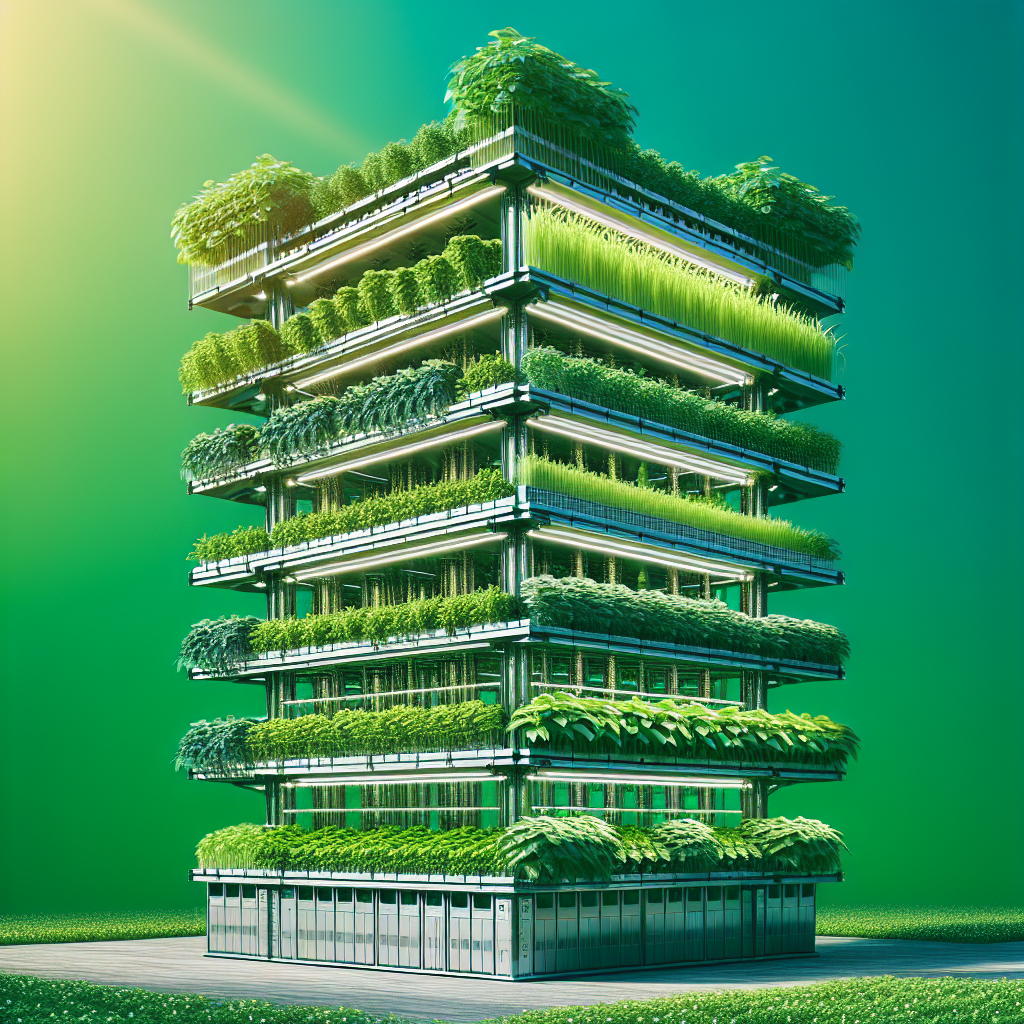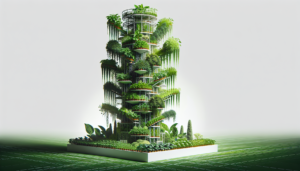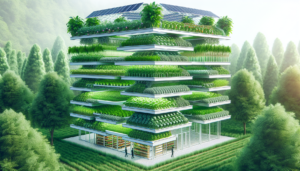
Are you curious about the future of agriculture and the potential benefits and drawbacks of vertical farming? Look no further as this article explores the pros and cons of this innovative farming method. From increased food production and reduced water usage to energy consumption and cost considerations, we’ll delve into the key aspects of vertical farming so you can gain insight into whether it’s a viable solution for sustainable and efficient food production. So, let’s explore the world of vertical farming together and weigh the pros and cons along the way.
Advantages of Vertical Farming
Vertical farming is an innovative agricultural practice that involves growing crops in vertically stacked layers, such as in a high-rise building or a greenhouse. This modern approach to farming offers numerous advantages that can revolutionize the way we produce food. From maximizing limited space to reducing water usage and increasing food safety, vertical farming has the potential to address some of the pressing challenges facing traditional agriculture. Let’s dive deeper into the advantages of vertical farming and explore why it is gaining popularity worldwide.
Maximizing Limited Space
One of the primary advantages of vertical farming is its ability to maximize limited space. In a traditional farming setup, horizontal land is needed, which often results in expansive fields occupying vast areas. However, with vertical farming, crops can be grown in vertically stacked layers, allowing for efficient land use. This is particularly beneficial in urban areas where available land is scarce. By utilizing vertical space, vertical farms can produce an impressive amount of food in a fraction of the space required by traditional farms.
Year-Round Crop Production
Vertical farming offers the advantage of year-round crop production, regardless of the season or weather conditions. Traditional farming methods are heavily reliant on natural weather patterns and seasonal constraints. In contrast, vertical farms create controlled environments where temperature, humidity, and light can be precisely adjusted to optimize crop growth. This allows for continuous harvesting and eliminates the seasonal limitations that affect traditional agriculture. By providing a stable and controlled climate, farmers can grow crops consistently throughout the year.
Reduced Water Usage
Water scarcity is a growing concern worldwide, making efficient water usage a crucial aspect of sustainable farming practices. Vertical farming addresses this issue by implementing water-saving technologies and recirculation systems. In traditional farming, a significant amount of water is lost through evaporation and inefficient irrigation methods. However, in vertical farms, water can be efficiently circulated, filtered, and reused, minimizing water wastage. By reducing water usage, vertical farming helps preserve this precious resource and contributes to overall sustainability.
Eliminating Weather-related Risks
Traditional farmers face numerous challenges due to unpredictable weather conditions, including droughts, storms, and extreme temperatures. These factors can significantly impact crop yields and pose risks to food security. Vertical farming eliminates weather-related risks by providing a protected, controlled environment for crops. By growing plants indoors or in climate-controlled greenhouses, vertical farms can shield crops from adverse weather conditions, ensuring stable crop growth and reducing crop losses. This advantage not only enhances food production but also increases the resilience of farming operations.
Decreased Dependency on Pesticides
Vertical farming offers a significant advantage in terms of reducing dependency on pesticides. In conventional farming, excessive pesticide use can have detrimental effects on human health and the environment. However, vertical farms provide a controlled environment where pests can be effectively managed without relying on harmful chemical pesticides. Integrated pest management techniques, such as biological control methods and precision monitoring, can be implemented to prevent and control pest infestations. This reduced dependency on pesticides promotes a more sustainable and eco-friendly approach to farming.
Improved Food Safety
Food safety is a critical concern, and vertical farming presents unique advantages in this aspect. In traditional farming, crops are exposed to various potential contaminants, including harmful bacteria, pesticides, and environmental pollutants. In vertical farms, by maintaining a controlled environment, these risks can be significantly minimized. By carefully monitoring inputs, such as water quality and nutrient composition, vertical farms ensure that crops are grown under strict hygiene standards. This focus on food safety provides consumers with fresher, safer produce that is less likely to be contaminated.
Enhanced Nutritional Value
Vertical farms have the potential to produce crops with enhanced nutritional value. By controlling various environmental factors, such as light spectrum and nutrient levels, vertical farming can optimize the growth conditions for plants. This precision allows farmers to enhance the nutritional content of crops, ensuring they are rich in essential vitamins, minerals, and antioxidants. Additionally, by reducing the time between harvest and consumption, vertical farming preserves the nutritional integrity of the produce, resulting in fresher and more nutrient-dense food options for consumers.
Reduced Food Waste
The issue of food waste is a significant concern globally, with a substantial amount of food being lost or wasted at various stages of the supply chain. Vertical farming can help combat this problem by providing a more localized and efficient food production system. By growing crops closer to the consumer, vertical farms reduce the need for long-distance transportation, storage, and distribution. This proximity minimizes the time between harvest and consumption, thereby reducing the likelihood of spoilage and minimizing food waste. By adopting vertical farming, we can work towards building a more sustainable and efficient food system.
Job Creation
Vertical farming not only offers numerous benefits for food production but also creates employment opportunities. As this innovative practice continues to gain momentum, the demand for skilled vertical farm technicians, engineers, and agricultural scientists is increasing. The vertical farming industry contributes to job creation, particularly in urban areas where the farms are often situated. This provides opportunities for individuals interested in sustainable agriculture and helps stimulate local economies through the creation of new employment avenues.
Local Food Production
Another advantage of vertical farming is its potential to promote local food production. By establishing vertical farms in urban areas, fresh produce can be grown and distributed locally. This reduces the need for extensive transportation networks and decreases the carbon footprint associated with long-distance food transportation. Local food production also strengthens food security and fosters community resilience by reducing reliance on distant sources. Furthermore, consuming locally grown food enhances the connection between consumers and the farmers, promoting a sense of community and supporting local businesses.
Disadvantages of Vertical Farming
While vertical farming offers numerous advantages, it is important to consider the potential disadvantages associated with this innovative agricultural practice. Understanding the challenges and limitations of vertical farming helps us evaluate its feasibility and ensures a balanced perspective on its implementation. Let’s explore some of the disadvantages that need to be addressed when considering vertical farming.
High Initial Investment
One significant disadvantage of vertical farming is the high initial investment required to set up and maintain a vertical farm. The technology and infrastructure needed for controlled-environment agriculture can be costly, including construction, lighting systems, climate control equipment, and advanced growing systems. This initial cost can be a barrier for individuals or communities with limited financial resources, hindering widespread adoption. However, as technology advances and economies of scale are realized, the cost of vertical farming is expected to decrease, making it more accessible to a broader range of farmers and investors.
Energy Consumption
Vertical farming relies heavily on artificial lighting, which consumes a considerable amount of energy. Plants require specific light spectrums and durations to grow optimally, and providing these conditions in an indoor setting can be energy-intensive. Additionally, climate control systems, irrigation, and nutrient delivery systems also contribute to the overall energy consumption of a vertical farm. This energy dependence raises concerns about the environmental impact and sustainability of vertical farming. To overcome this disadvantage, the development and utilization of energy-efficient technologies and renewable energy sources should be explored.
Technical Challenges
Implementing and managing vertical farms come with a set of technical challenges. Controlling and maintaining optimal environmental conditions, such as temperature, humidity, and CO2 levels, is crucial for successful vertical farming. Achieving the right balance requires advanced sensors, automation systems, and sophisticated algorithms. Furthermore, the complexity of these systems may require specialized knowledge and expertise. Overcoming these technical challenges and ensuring the reliable and efficient operation of vertical farms can pose difficulties, particularly for individuals who are new to this form of agriculture.
Limited Crop Varieties
Vertical farming is better suited for certain types of crops, primarily leafy greens and herbs, due to their compact size and rapid growth. However, the cultivation of large-fruited or root vegetables, such as tomatoes or carrots, can be challenging in the limited space of a vertical farm. This limitation can restrict the diversity of crops that can be commercially viable in vertical farming systems. While advancements in technology and research may expand the range of crop varieties that can be successfully grown vertically, this remains a disadvantage when compared to the broader crop variety available in traditional farming.
Potential for Monoculture
The vertical farming setup might be prone to monoculture, where a single crop is grown on a large scale. While monoculture can maximize crop yield and simplify management, it poses risks such as increased vulnerability to diseases and pests. In a controlled environment, a disease or pest outbreak can spread rapidly and devastate an entire crop. Maintaining crop diversity to mitigate these risks requires careful planning and management strategies. By incorporating suitable crop rotation practices and diversifying the selection of crops, vertical farms can reduce the potential for monoculture and enhance long-term sustainability.
Issues with Scaling
Vertical farming has the potential for scalability and expansion. However, as farms increase in size and complexity, various operational challenges arise. Scaling up vertical farms requires careful consideration of factors such as irrigation systems, lighting infrastructure, logistical arrangements, and workforce management. Maintaining consistency and quality control across multiple layers and levels of production can also present logistical hurdles. Consequently, vertical farming operations must plan and implement scaling strategies that ensure efficient production without compromising quality or increasing operational complexities.
Dependency on Artificial Light
Vertical farming relies on artificial lighting to provide the necessary light spectrum for plant growth. While this allows for year-round production, it also introduces a dependency on energy-intensive lighting systems. The continuous need for artificial lighting raises concerns about sustainability and environmental impact. Additionally, the cost associated with providing and maintaining artificial lighting can be significant. To mitigate this disadvantage, efforts are being made to develop energy-efficient LED lighting systems and explore alternative light sources, such as natural sunlight supplemented with artificial lighting.
Questionable Sustainability
While vertical farming is considered a sustainable farming practice in many aspects, certain factors raise questions regarding its overall sustainability. As mentioned earlier, the high energy consumption associated with artificial lighting and climate control systems may raise concerns about the ecological footprint of vertical farming. Additionally, the use of non-renewable resources for infrastructure materials and the disposal of waste generated from vertical farms may impact sustainability. To address these concerns, vertical farming should embrace circular economy principles, including the use of renewable materials, efficient resource management, and responsible waste disposal strategies.
Higher Production Costs
The high initial investment and energy consumption of vertical farms contribute to higher production costs compared to traditional farming methods. When considering the economic viability of vertical farming, these increased costs must be taken into account. The expense of constructing and maintaining a vertical farm, along with the ongoing energy and operational costs, can pose challenges in achieving cost competitiveness. However, as technology continues to evolve and vertical farming practices become more streamlined, production costs are expected to decrease, making this form of agriculture more economically feasible.
Limited Crop Yields
The limited space available for crop production in vertical farms can result in lower crop yields compared to traditional farming on a per-unit area basis. While vertical farming excels in maximizing the use of vertical space, the actual land area available for crop growth is typically smaller than that used in conventional farming. This limitation can lead to decreased overall crop yields, which must be carefully considered when evaluating the productivity and efficiency of vertical farming. Strategies to optimize crop density and improve vertical growth techniques are being explored to mitigate this disadvantage and increase yields.
In conclusion, vertical farming offers numerous advantages that have the potential to revolutionize the way we grow food. From addressing limited space constraints to providing year-round crop production and reducing water usage, vertical farming presents solutions to some of the major challenges faced by traditional agriculture. However, it is essential to acknowledge the associated disadvantages, such as high initial investment costs, energy consumption, and limitations in crop varieties and yields. Understanding and addressing these challenges will be crucial in realizing the full potential of vertical farming and ensuring its sustainability and long-term viability. As technology continues to advance and practices are refined, vertical farming has the opportunity to play a significant role in feeding our growing global population while minimizing the impact on the environment.







